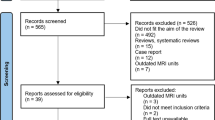Abstract
Objectives
Artefacts caused by orthodontic attachments limit the diagnostic value and lead to removal of these appliances before magnetic resonance imaging. Magnetic permeability can predict the artefact size. There is no standardised approach to determine the permeability of such attachments. The aim was to establish a reliable approach to determine artefact size caused by orthodontic attachments at 1.5 T MRI.
Materials and methods
Artefact radii of 21 attachments were determined applying two prevalent sequences of the head and neck region (turbo spin echo and gradient echo). The instrument Ferromaster (Stefan Mayer Instruments, Dinslaken) is approved for permeability measurements of objects with a minimum size (d = 20 mm, h = 5 mm). Eleven small test specimens of known permeability between 1.003 and 1.431 were produced. They are slightly larger than the orthodontic attachments. Their artefacts were measured and cross tabulated against the permeability. The resulting curve was used to compare the orthodontic attachments with the test bodies.
Results
Steel caused a wide range of artefact size of 10–74 mm subject to their permeability. Titanium, cobalt-chromium and ceramic materials produced artefact radii up to 20 mm. Measurement of artefacts of the test bodies revealed an interrelationship according to a root function. The artefact size of all brackets was below that root function.
Conclusions
The permeability can be reliably assessed by conventional measurement devices and the artefact size can be predicted. The radiologist is able to decide whether or not the orthodontic attachments should be removed.
Clinical relevance
This study clarifies whether an orthodontic appliance must be removed before taking an MRI.




Similar content being viewed by others
References
Okano Y, Yamashiro M, Kaneda T, et al. (2003) Magnetic resonance imaging diagnosis of the temporomandibular joint in patients with orthodontic appliances. Oral Surg Oral Med Oral Pathol Oral Radiol Endod 95:255–263
Kemper J, Klocke A, Kahl-Nieke B, Adam G (2005) Kieferorthopädische Brackets in der Hochfeld Magnetresonanz-Tomographie: Experimentelle Beurteilung magnetischer Anziehungs- und Rotationskräfte bei 3 Tesla. RoFo 177:1691–1698
Patel A, Bhavra GS, O’Neill JR (2006) MRI scanning and orthodontics. J Orthod 33:246–249
Hatch J, Deahl TS, Matteson SR (2014) CAT of the month: remove metallic orthodontic appliances prior to MRI imaging. Tex Dent J 131:26
Kajan ZD, Khademi J, Alizadeh A, Hemmaty YB, Roushan ZA (2015) A comparative study of metal artifacts from common metal orthodontic brackets in magnetic resonance imaging. Imaging Sci Dent 45:159–168
Blankenstein FH, Truong BT, Zachriat C, et al. (2015) About the predictability of susceptibility artifacts caused by metallic orthodontic appliances. J Orofac Orthop 76:14–29
Yassi K, Ziane F, Bardinet E, et al. (2007) Évaluation des risques d’échauffement et de déplacement des appareils orthodontiques en imagerie par résonance ma-gnétique. J Radiol 88:263–268
Regier M, Kemper J, Kaul MG, Feddersen M, Adam G, Kahl-Nieke B, Klocke A (2009) Radiofrequency-induced heating near fixed orthodontic appliances in high field MRI systems at 3.0 Tesla. J Orofac Orthop 70:485–494
Gorgülü S, Ayyildiz S, Kamburoglu K, Gokçe S, Ozen T (2014) Effect of orthodontic brackets and different wires on radiofrequency heating and magnetic field interactions during 3-T MRI. Dentomaxillofac Radiol. doi:10.1259/dmfr.20130356
Wezel J, Kooij BJ, Webb AG (2014) Assessing the MR combatibility of dental retainer wires at 7 Tesla. Magn Reson Med 72:1191–1198
Klocke A, Kahl-Nieke B, Adam G, Kemper J (2006) Magnetic forces on orthodontic wires in high field magnetic resonance imaging (MRI) at 3 Tesla. J Orofac Orthop 67:424–429
Elison JM, Leggitt VL, Thomson M, et al. (2008) Influence of common orthodontic appliances on the diagnostic quality of cranial magnetic resonance images. Am J Orthod Dentofac Orthop 134:563–572
Beau A, Bossard D, Gebeile-Chauty S (2015) Magnetic resonance imaging artefacts and fixed orthodontic attachments. Eur J Orthod 37:105–110
Wylezinska M, Pinkstone M, Hay N, et al. (2015) Impact of orthodontic appliances on the quality of craniofacial anatomical magnetic resonance imaging and real-time speech imaging. Eur J Orthod. doi:10.1093/ejo/cju103
Zachriat C, Asbach P, Blankenstein KI, Peroz I, Blankenstein FH (2015) Magnetic Resonance imaging with intraoral orthodontic appliance—a comparative in vitro and in vivo study of image artefacts at 1.5 Tesla. Dentomaxillofacial Radiol. doi:10.1259/dmfr.20140416
Herold T, Caro WC, Heers G, Perlick L, Grifka J, Feuerbach S, Nitz W, Lenhart M (2004) Influence of sequence type on the extent of the susceptibility artifact in MRI—a shoulder specimen study after suture anchor repair. Fortschr Rontgenstr (RoFo) 176(9):1296–1301
Blankenstein FH, Truong BT, Thomas A, Schröder RJ, Naumann M (2006) Signal loss in magnetic resonance imaging caused by intraoral anchored dental magnetic materials. Rofo 178:787–793
Bennett LH, Wang PS, Donahue MJ (1996) Artifacts in magnetic resonance imaging frim metals. J Appl Phys 79:4712–4714
Fache JS, Price C, Hawbolt EB, Li DK (1987) MR imaging artifacts produced by dental materials. Am J Neuroradiol 8:837–840
Nitz WR, Runge VM, Schmeets SH (2011) Praxiskurs MRT. Georg Thieme Verlag, Stuttgart, New York, p. 201
Author information
Authors and Affiliations
Corresponding author
Ethics declarations
Conflict of interest
All authors declare that they have no conflicts of interests. Dr. rer. nat. Stefan Mayer, co-author of this manuscript and owner of the Stefan Mayer Instruments Company in Dinslaken, undertook the permeability measurements of all samples and produced the carbonyl-iron test specimens. No financial or material means were provided for this research collaboration. The artefact measurements and image evaluations were conducted separately from the permeability measurement and were done exclusively in the Berlin study group.
Funding
The 21 orthodontic attachments have been provided without cost by five producers (Table 2).
Ethical approval
This article does not contain any studies with human participants or animals performed by any of the authors.
Informed consent
It is not necessary, because no individual participants were included.
Rights and permissions
About this article
Cite this article
Blankenstein, F.H., Asbach, P., Beuer, F. et al. Magnetic permeability as a predictor of the artefact size caused by orthodontic appliances at 1.5 T magnetic resonance imaging. Clin Oral Invest 21, 281–289 (2017). https://doi.org/10.1007/s00784-016-1788-1
Received:
Accepted:
Published:
Issue Date:
DOI: https://doi.org/10.1007/s00784-016-1788-1




